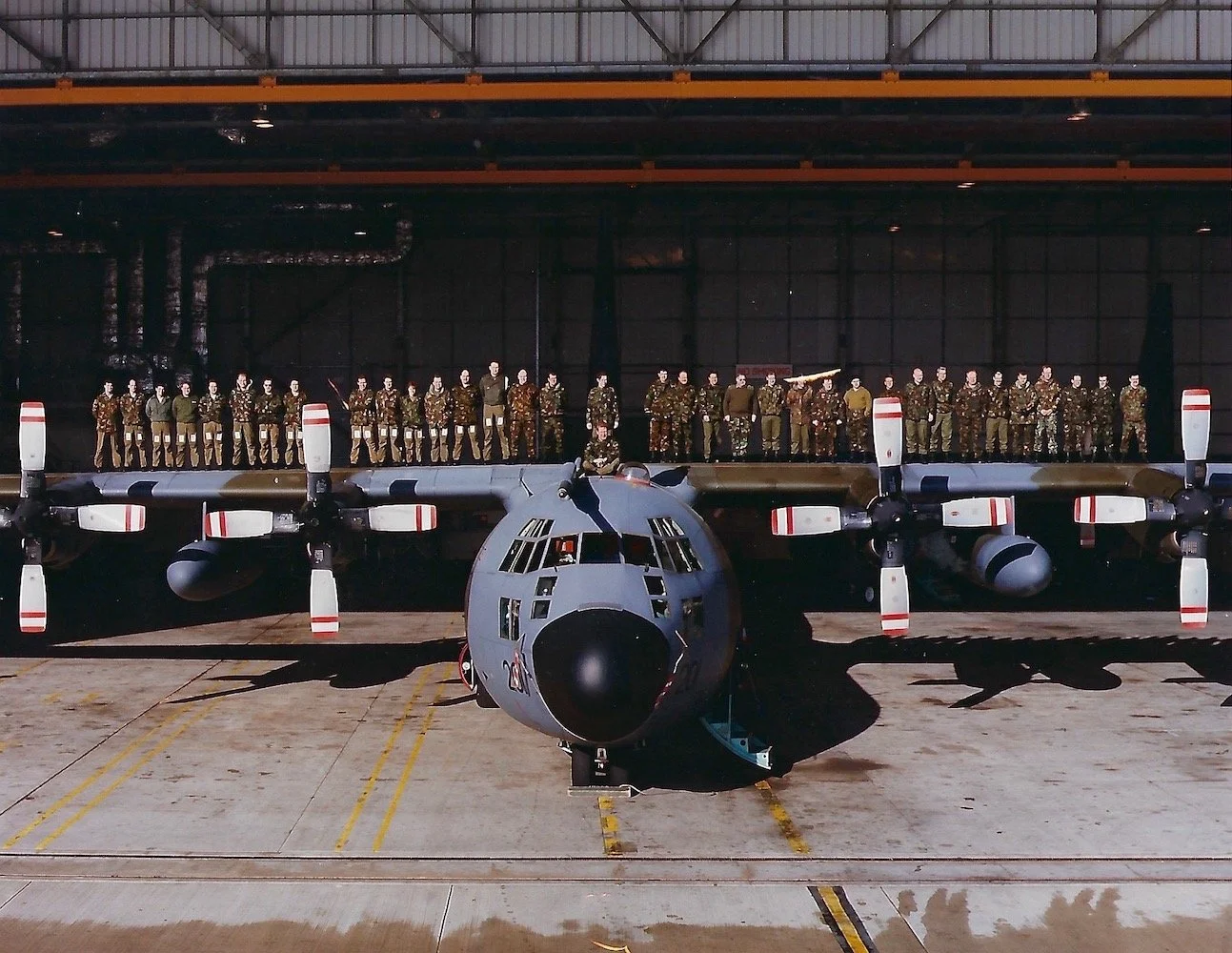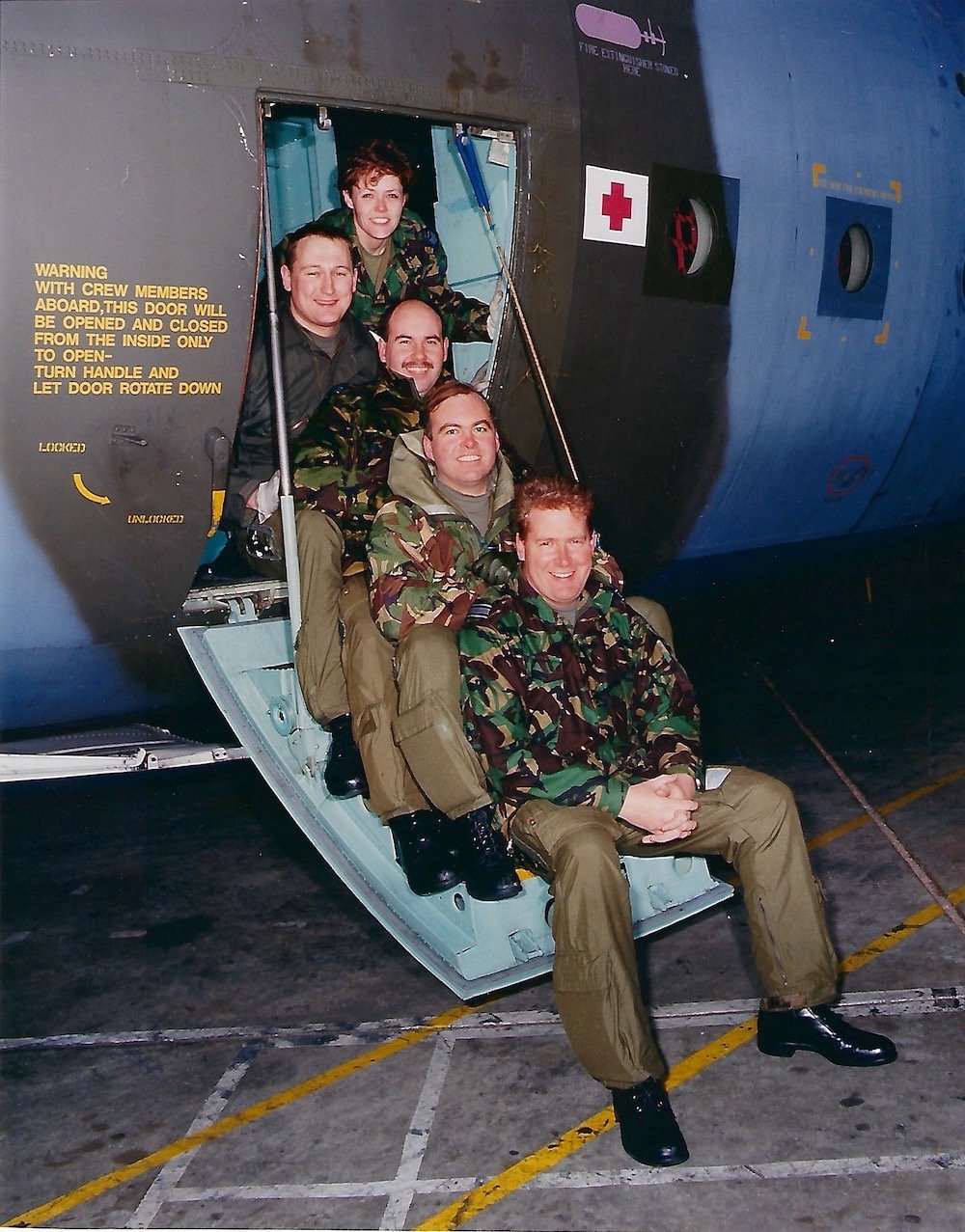Laurie Ramage - SAR Falklands
1312 Flt flight crew and engineers - Aug 1995
In 1995 I was OC 1312 Flight in the Falkland Islands. My crew and I were there for four months with another 2 crews from 30 and 24 Squadrons. Our role in theatre was to carry out air-to-air refuelling tasks to keep the resident F3’s in the air for longer; complete Maritime Radar Recognisance (MRR) inside the protected 200nm radius around the Falkland Islands to make sure there was no sneaky-beaky stuff going on, casualty evacuation (Casevac); and, Quick Reaction Alert (QRA).
On 21 August 1995 it was our turn to be on QRA and my crew and I were just settling down for the night when an engineer popped his head around my door and said, “Boss, we’ve got a shout!”. He stated that we have had an unusual request from Sea King Operations to say they has been scrambled to assist a seaman with a serious head injury on a Polish trawler somewhere to the west of the Falklands. My immediate thought was ‘OK, what did they want us to do?’ By now all my crew were up and ready for action. Well, explained the engineer, firstly, could we find the ship for them so they could go straight for it; secondly, could we be there relay station because they would be flying quite low; and thirdly, could we keep tabs on them in case they ended up in the drink. They knew we has ASRA survival equipment on board, but they also knew we couldn’t save the whole crew, so all they wanted us to do was note where they ditched if things went wrong, and tell their families where it happened. Now, this may sound dramatic but it was a god-awful night and just on the operational limits for us and the Sea King.
Even though all our aircraft were prepared for QRA, I have to hand it to my ground engineers because they got that Herc (XV203) ready in record time. My crew were listening to what was going on so they required very little briefing and off we went!
From the top: Flo Shouls (Eng), Chewy Wade (ALM), Rich Cooke (Nav), Rob Bridges (Co-pilot), Laurie Ramage (Capt)
The Sea King was already on its way and we quickly passed them as we headed to the general area. Rich Cooke, my navigator, had the rough co-ordinates of the fishing boat we were looking for so at least we had a good idea where the boat might be. As we got closer it soon became clear that there were boats everywhere - so which one was it?! Rob Bridges finally managed to make contact with the correct vessel and asked them to fire a red flare so we could home in on them. This was not an easy task for Rob as the captain spoke very little English!
By now the helicopter could see us orbiting the vessel and made a bee-line for us. The sea was very rough that night and the ship was like a cork bobbing in boiling water. It was the kind of sea that makes you feel queasy just looking at it - and we were about to spend over an hour doing just that! I do remember thinking there was no way the Sea King crew were going to get a line on that vessel let alone get a very brave doctor on board. After what seemed like an eternity of watching them trying, to our amazement, they did it! They extracted the injured party who by all accounts was in a pretty poor state and beat a track straight back to Mount Pleasant Airfield. To be honest, we’d had enough of orbiting the scene and were only too happy to be on our way back, zig-zagging behind the Sea King to keep an eye on it.
Once over land we said goodbye to our helicopter friends and headed straight home: it was now 3:30am. However, the drama was not quite over. As we made our approach to the westerly runway, at about 300’ - the runway lights went out! What on earth happened? It was honestly like the ‘black hole of Calcutta’, so around we went. Naturally we were somewhat vexed by this and asked - politely - what had happened. The controller said rather sheepishly “Boddington!”.
As you are probably aware, back then ATC controlled the airfield lights via a large lighting panel lit up by lots of lovely warm lights (non of your fancy touch-screen computers here) - and cats like to be warm don’t they?. Yes, Boddington was the ATC cat! Apparently Boddington had decided to wake up and stretch at that very moment, and somehow pushed the button marked OFF! I can’t say I’ve ever been a cat-lover, and I certainly wasn’t then.
Anyway, having safely landed off the second approach, ATC bought us a couple of slabs of beer so all was forgiven.
As an aside, the FI hospital couldn’t deal with the injuries the fisherman had sustained so two days later we casevac’d him to Santiago - and that’s another story!
1312 Flt, ATC and Fire Section


